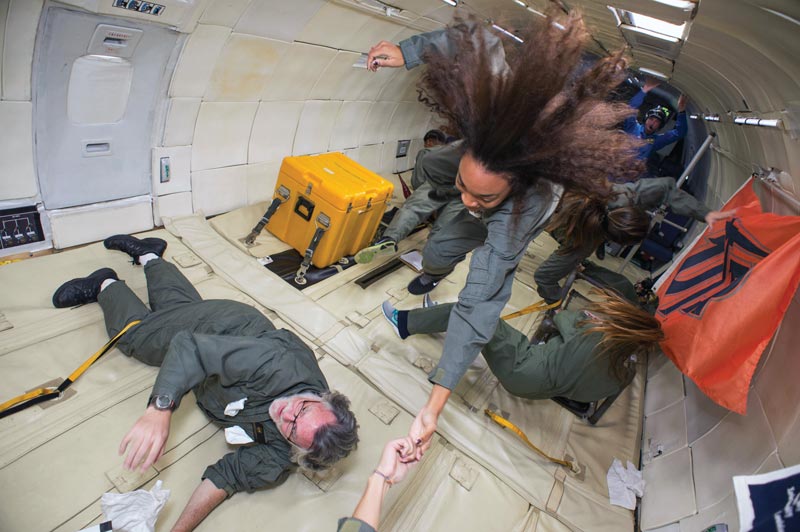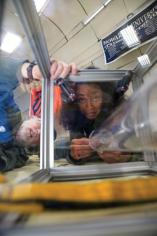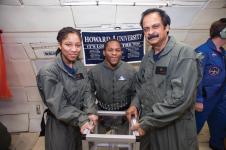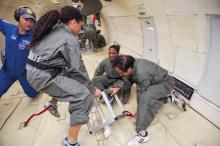Defying Gravity
Spring
2014
Interactions - SPS Chapters in Action
Defying Gravity
Howard University team takes a ride on the “Vomit Comet”
By:Janelle Holmes with Ajamu Abdullah and Aara’L Yarber
Howard University

Altitude: 34,000 feet. Speed: 469 knots. G-Force: variable.
I’m floating above the Gulf of Mexico in the cabin of a Boeing 727, fighting off an exhilarating mixture of elation and nausea. My teammates and I are so focused on keeping our free-floating experiment steady that we forget to keep ourselves in check until thud! Ajamu and I knock heads. Luckily, the experiment itself isn’t affected by our Bad News Bears-esque collision. The flight lasts for about a half hour, as the NASA plane follows parabolic paths that cause the force of gravity to vary between 0 and 2 G’s. The discomfort brought on by having our weight doubled during each pullout is more than worth the subsequent elation brought on by each short period of weightlessness.
The goal of our Howard University team is to observe in microgravity the effects of Rayleigh instability, a phenomenon that explains why water from a shower head falls as droplets rather than as continuous columns. Liquids are typically subject to two forces: surface tension and gravity. On Earth the force of gravity dominates surface tension, and a liquid column develops an instability, small perturbations that cause the diameter of the column to shrink and lead to the breakup of the column into droplets. These droplets form because molecules at the surface of the liquid have a higher energy than those inside. Natural processes proceed to the lowest possible energy state, so water will minimize its surface area by taking the shape of a sphere.
 Without the dominating force of gravity, our team expected to be able to form a liquid column that would not break up into droplets as quickly as it would on Earth. We got our research proposal approved by NASA in the spring of 2013 and began assembling a team. Dr. Prabhakar Misra, our SPS faculty advisor and interim chair of Howard University’s department of physics and astronomy, was the organizer. Ajamu Abdullah, Ryan O’Donnell, Aara’L Yarber, and I were all undergraduate physics majors. We would be working with Raul Garcia, a graduate student, and our NASA advisor, Dr. Brian Carpenter.
Without the dominating force of gravity, our team expected to be able to form a liquid column that would not break up into droplets as quickly as it would on Earth. We got our research proposal approved by NASA in the spring of 2013 and began assembling a team. Dr. Prabhakar Misra, our SPS faculty advisor and interim chair of Howard University’s department of physics and astronomy, was the organizer. Ajamu Abdullah, Ryan O’Donnell, Aara’L Yarber, and I were all undergraduate physics majors. We would be working with Raul Garcia, a graduate student, and our NASA advisor, Dr. Brian Carpenter.
The experiment was simple in principle; however, we faced quite a few logistical challenges. Flight week was to occur in early November 2013, which meant that many of our deadlines occurred over the preceding summer and early fall. Due to conflicting schedules, it was impossible for any of us to meet up until the fall semester began. When we were finally able to meet, we had to hustle to finalize our experiment design, order parts, build the apparatus, test it, and complete our test equipment data package, a detailed report designed to verify the structural design and safety of an experiment.
One of the main challenges was to design an experimental apparatus that could smoothly push water out of a syringe to form a stable column. We also had to develop a means to minimize water leakage and construct a sturdy frame that would allow team members to observe the  liquid column and hold everything steady while floating in microgravity. We solved these issues, and everything was coming together smoothly—until October.
liquid column and hold everything steady while floating in microgravity. We solved these issues, and everything was coming together smoothly—until October.
In October the government shut down. Our project had been made possible through the partnership of two government programs: NASA’s Reduced Gravity Education Flight Program (which provides opportunities for K–12 teams to fly microgravity experiments) and its Minority University Research Education Program. These nonessential programs were put on hold during the shutdown. We were not able to communicate with our NASA program coordinators during this time, and we were not sure if flight week would even occur. Fortunately, the program coordinators were able to get everything back up and running quickly after the shutdown ended. Flight week was pushed back and slightly abbreviated, but it was still going to happen.
So on November 7, 2013, Howard University’s microgravity team arrived in Houston, Texas. Over the course of a few days, we finalized our experiment and answered questions regarding the safety of our apparatus. We worked in a hangar at Ellington Field, where we attended meetings and were instructed on the strict rules regarding both our experiment and our behavior on site.
NASA put us on a two-strike system. Two mistakes, and we would not fly. I’m proud to say that Howard University’s team received no strikes, and we all got to fly.
In the days and moments before liftoff, we were schooled in the steps we should take to prevent motion sickness during the flight. “Don’t move your head around,” we were told. “Don’t flip upside down or look out the window.” Most importantly, we were given a drug called scopolamine that helps to prevent motion sickness. I’m proud to say that every Howard University team member kept his or her lunch—despite the nickname of the plane, the “Vomit Comet.”
 I had the songs “Defying Gravity” and “You Can Fly!” on repeat in the back of my mind for the entire flight, but neither song adequately describes the microgravity experience—there are few analogies that can. Imagine being on a roller coaster at that fleeting moment when the cars have crested the top of the incline and are about to plummet back toward the Earth. Now imagine that fleeting moment of weightlessness stretched out to last for 15 to 20 seconds. That’s the best I can do.
I had the songs “Defying Gravity” and “You Can Fly!” on repeat in the back of my mind for the entire flight, but neither song adequately describes the microgravity experience—there are few analogies that can. Imagine being on a roller coaster at that fleeting moment when the cars have crested the top of the incline and are about to plummet back toward the Earth. Now imagine that fleeting moment of weightlessness stretched out to last for 15 to 20 seconds. That’s the best I can do.
In the end, we were able to capture video footage of water columns being formed and breaking up due to Rayleigh instability, which supported our hypothesis. It took a lot of time and effort to reach that point, but it was all definitely worthwhile. We rounded out the experience with tours of Ellington Field, Johnson Space Center, and the Neutral Buoyancy Laboratory. Needless to say, it was an unforgettable experience that I wish every aspiring physicist could have. //
